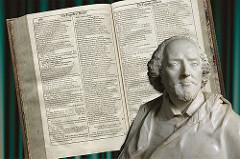Rare, first edition of Shakespeare plays comes to Tulane
Shakespeare fans from across Louisiana are expected to converge on the Tulane University campus this spring when the Newcomb Art Museum opens the highly anticipated exhibition First Folio! The Book That Gave Us Shakespeare.
The national traveling exhibition, marking the 400th anniversary of William Shakespeare’s death, will open May 9 for three weeks, giving visitors an up-close view of one of the world’s rarest books. Published in 1623, the First Folio is the first collected edition of Shakespeare’s plays, including Macbeth, Julius Caesar, Twelfth Night and Hamlet.
“We are honored to host the First Folio during its national tour,” said museum director Monica Ramirez-Montagut. “From illicit love affairs to political intrigue, the themes of Shakespeare’s works have long engaged scholars and popular culture enthusiasts alike.”
The museum is teaming up with the Tulane School of Liberal Arts to host the exhibit, which will open with a jazz funeral led by musician Michael White and the Liberty Brass Band beginning at 6:30 p.m. on the Newcomb Quad. The exhibition will include a multi-panel display exploring the significance of Shakespeare, then and now, with additional interactive activities.
“Shakespeare is for everybody,” said Michael Kuczynski, chairman of the Tulane Department of English and site coordinator for the project. “This exhibition will enable the New Orleans and wider Louisiana community to encounter Shakespeare and his book directly and intimately.”
Coinciding with the exhibition will be lectures, readings, workshops and related exhibits, both on and off campus, as well as the Shakespeare Festival at Tulane. For a list of activities and collaborators, go to firstfolio.tulane.edu.
Tulane was selected as the Louisiana host site for the exhibition by the Folger Shakespeare Library in Washington, D.C., home to the world’s largest Shakespeare collection and a primary repository for rare materials from 1500 to 1750. It is being produced in association with the American Library Association and the Cincinnati Museum Center, with major funding from the National Endowment for the Humanities.

